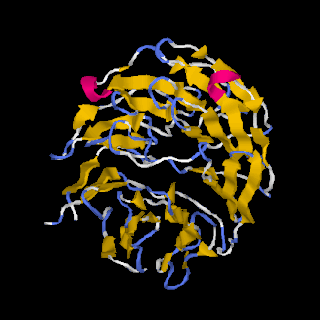
Neuroblastoma breakpoint family, member 1, or NBPF1, is a protein that is encoded by the gene NBPF1 in humans. This protein is member of the neuroblastoma breakpoint family of proteins, a group of proteins that are thought to be involved in the development of the nervous system.

C8orf48 is a protein that in humans is encoded by the C8orf48 gene. C8orf48 is a nuclear protein specifically predicted to be located in the nuclear lamina. C8orf48 has been found to interact with proteins that are involved in the regulation of various cellular responses like gene expression, protein secretion, cell proliferation, and inflammatory responses. This protein has been linked to breast cancer and papillary thyroid carcinoma.
CXorf49 is a protein, which in humans is encoded by the gene chromosome X open reading frame 49(CXorf49).
The coiled-coil domain containing 142 (CCDC142) is a gene which in humans encodes the CCDC142 protein. The CCDC142 gene is located on chromosome 2, spans 4339 base pairs and contains 9 exons. The gene codes for the coiled-coil domain containing protein 142 (CCDC142), whose function is not yet well understood. There are two known isoforms of CCDC142. CCDC142 proteins produced from these transcripts range in size from 743 to 665 amino acids and contain signals suggesting protein movement between the cytosol and nucleus. Homologous CCDC142 genes are found in many animals including vertebrates and invertebrates but not fungus, plants, protists, archea, or bacteria. Although the function of this protein is not well understood, it contains a coiled-coil domain and a RINT1_TIP1 motif located within the coiled-coil domain.

PRR29 is a protein encoded by the PRR29 gene located in humans on chromosome 17 at 17q23.
Coiled-coil domain containing protein 180 (CCDC180) is a protein that in humans is encoded by the CCDC180 gene. This protein is known to localize to the nucleus and is thought to be involved in regulation of transcription as are many proteins containing coiled-coil domains. As it is expressed most highly in the testes and is regulated by SRY and SOX transcription factors, it could be involved in sex determination.
Leukocyte Receptor Cluster Member 9 is an uncharacterized protein encoded by the LENG9 gene. In humans, LENG9 is predicted to play a role in fertility and reproductive disorders associated with female endometrium structures.

KIAA1211L is a protein that in humans is encoded by the KIAA1211L gene. It is highly expressed in the brain. Furthermore, it is localized to the microtubules and the centrosomes and is subcellularly located in the nucleus. Finally, KIAA1211L is associated with certain mental disorders and various cancers.

C17orf53 is a gene in humans that encodes a protein known as C17orf53, uncharacterized protein C17orf53. It has been shown to target the nucleus, with minor localization in the cytoplasm. Based on current findings C17orf53 is predicted to perform functions of transport, however further research into the protein could provide more specific evidence regarding its function.

Chromosome 21 Open Reading Frame 58 (C21orf58) is a protein that in humans is encoded by the C21orf58 gene.

WD repeat containing protein 53 (WDR53) is a protein encoded by the WDR53 gene that has been identified in the human genome by the Human Genome Project but has, at the moment, lacked experimental procedures to understand the function. It is located on chromosome 3 at location 3q29 in Homo sapiens. It has short up and down stream untranslated regions as well as WD40 repeat regions which have been linked to various functions.
C2orf81 is a human gene encoding protein c2orf81, which is predicted to have nuclear localization.

Chromosome 19 open reading frame 44 is a protein that in humans is encoded by the C19orf44 gene. C19orf44 is an uncharacterized protein with an unknown function in humans. C19orf44 is non-limiting implying that the protein exists in other species besides human. The protein contains one domain of unknown function (DUF) that is highly conserved throughout its orthologs. This protein is most highly expressed in the testis and ovary, but also has significant expression in the thyroid and parathyroid. Other names for this protein include: LOC84167.

LOC101059915 is a protein, which in humans is encoded by the LOC101059915 gene. It is located on the X chromosome and has restricted expression in the testis.

Chromosome 4 open reading frame 51 (C4orf51) is a protein which in humans is encoded by the C4orf51 gene.

Cilia- and flagella-associated protein 299 (CFAP299), is a protein that in humans is encoded by the CFAP299 gene. CFAP299 is predicted to play a role in spermatogenesis and cell apoptosis.

Leucine rich single-pass membrane protein 2 is a single-pass membrane protein rich in leucine, that in humans is encoded by the LSMEM2 gene. The LSMEM2 protein is conserved in mammals, birds, and reptiles. In humans, LSMEM2 is found to be highly expressed in the heart, skeletal muscle and tongue.

Family with sequence 98, member C or FAM98C is a gene that encodes for FAM98C has two aliases FLJ44669 and hypothetical protein LOC147965. FAM98C has two paralogs in humans FAM98A and FAM98B. FAM98C can be characterized for being a Leucine-rich protein. The function of FAM98C is still not defined. FAM98C has orthologs in mammals, reptiles, and amphibians and has a distant orhtologs in Rhinatrema bivittatum and Nanorana parkeri.

C11orf98 is a protein-encoding gene on chromosome 11 in humans of unknown function. It is otherwise known as c11orf48. The gene spans the chromosomal locus from 62,662,817-62,665,210. There are 4 exons. It spans across 2,394 base pairs of DNA and produces an mRNA that is 646 base pairs long.

C4orf19 is a protein which in humans is encoded by the C4orf19 gene.















